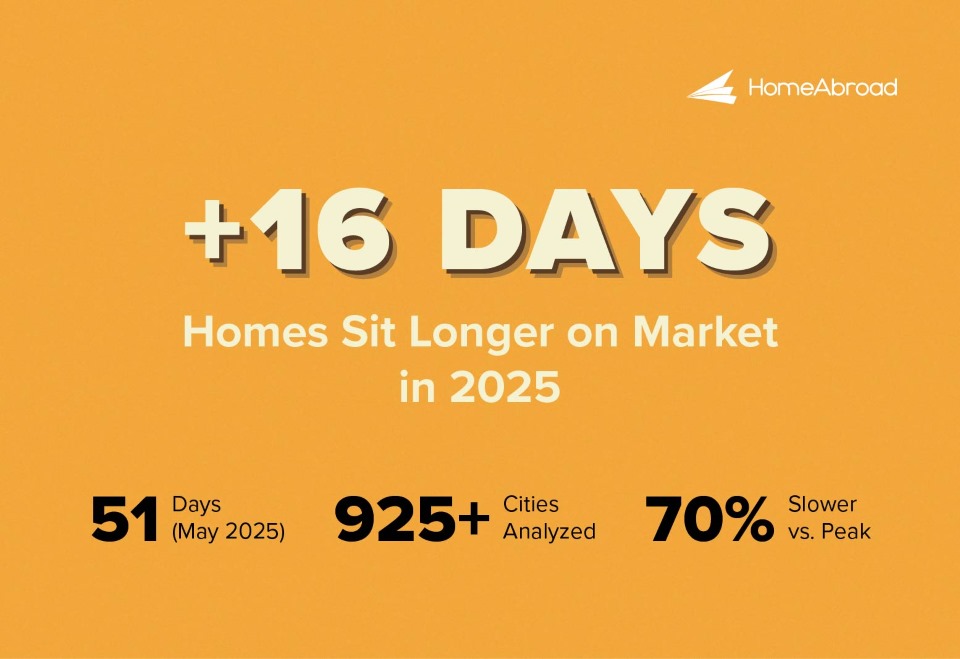Editorial Integrity
Making informed real estate decisions starts with having the right knowledge. At HomeAbroad, we offer US mortgage products for foreign nationals & investors and have a network of 500+ expert HomeAbroad real estate agents to provide the expertise you need. Our content is written by licensed mortgage experts and seasoned real estate agents who share insights from their experience, helping thousands like you. Our strict editorial process ensures you receive reliable and accurate information.
Just 32.6% of California homes are selling above asking price, down from 43.1% during the pandemic peak in 2022. That’s the biggest cooling we’ve seen since the market frenzy began, yet it’s still well above the 27.7% baseline from 2019.
This shift signals California is moving toward more balanced market conditions across most of its 37 metro areas. For comparison, more than 70% of homes sold above list price in some Bay Area markets during 2022’s peak madness. Today, even Silicon Valley’s hottest markets have cooled significantly, though they still lead the state.
The data, spanning 37 metropolitan areas, reveals a market successfully normalizing without triggering the dramatic corrections many predicted.
Table of Contents
Key Highlights
1. California's above-list competition dropped from 43.1% in 2022 to 32.6% in 2025, representing a 10.6% point decline. This cooling occurred without triggering price crashes, indicating healthy market normalization rather than speculative collapse.
2. Three markets (San Jose (61.9%), San Francisco (61.3%), and Oakland (60.4%)) form an exclusive 60%+ tier, separated by a 16.1% point gap from the next highest market. This concentration reflects tech wealth's geographic clustering and structural supply constraints.
3. Despite significant cooling, 2025 levels exceed 2019's 27.7% statewide average by 4.9% points, indicating California has established a new competitive equilibrium driven by structural housing shortages and changed buyer behavior patterns.
California Above-List Price Home Sales Statistics [2025]
1. California Above-List Price Home Sales Fell 2.6 Points Year-Over-Year from 35.1% in 2024 to 32.6% in 2025
California’s 32.6% above-list rate represents a -2.6% point drop from 2024’s 35.1% average, the first meaningful year-over-year decline since the pandemic began. More dramatically, it’s down -10.6 percentage points from 2022’s peak of 43.1%, when bidding wars were the norm rather than the exception.
Put simply: buyers today face roughly one-third less competition than during the market’s most frenzied period, while still dealing with more competition than the pre-pandemic baseline of 27.7% in 2019.
2. 3 of 37 California Markets (8%) Still Have 50%+ of Homes Selling Above List Price in May 2025.
Only 3 of 37 metros maintain ultra-competitive conditions where buyers routinely bid way over asking. These are exclusively Bay Area tech markets where cash buyers and stock options create bidding wars that ignore normal economics.
If you’re buying in San Jose, San Francisco, or Oakland, you’re still in extreme seller’s market territory. Budget 15-20% over list price and bring proof of funds.
3. 9 of 37 California Markets (24%) Have 40-50% of Homes Selling Above List Price, Including Los Angeles at 42.3%.
9 metros fall into this tier, including Los Angeles (42.3%) and several Bay Area spillover markets. These areas see consistent competition but not the insanity of the ultra-premium tier.
Expect competition, but you won’t need to waive every contingency. Target 10-15% over list and keep inspection rights.
4. 17 of 37 California Markets (46%) Show 30-40% Above-List Price Sales, with Sacramento at 40.1% and Fresno at 36.8%.
17 metros offer the best balance of reasonable competition with solid economic fundamentals. This includes most Central Valley and secondary coastal markets.
Sweet spot for most buyers. Markets like Sacramento (40.1%) and Fresno (36.8%) offer competition without chaos.
5. 8 of 37 California Markets (22%) Have Less Than 30% Above-List Price Sales, with Crescent City Lowest at 15.8%.
8 metros, mostly rural Northern California, offer genuine buyer advantages. In markets like Crescent City (15.8%) and Ukiah (19.1%), sellers are accepting offers below asking.
These markets offer affordability but limited job growth. Great for retirees or remote workers, risky for traditional career buyers.
Top 10 California Markets with Highest Above-List Price Home Sales Rates (May 2025)
Where sellers maintain strongest pricing power.
Rank | Metro | Avg. of Homes Sold Above List |
|---|---|---|
1. | San Jose, CA | 60.0% |
2. | San Francisco, CA | 59.9% |
3. | Oakland, CA | 54.2% |
4. | San Rafael, CA | 48.2% |
5. | Vallejo, CA | 45.8% |
6. | Los Angeles, CA | 43.4% |
7. | Modesto, CA | 41.2% |
8. | Hanford, CA | 41.0% |
9. | Chico, CA | 39.6% |
10. | Santa Cruz, CA | 39.4% |
Top 10 California Markets with Lowest Above-List Price Home Sales Rates (May 2025)
Where buyers find strongest negotiating position.
Rank | Metro | Avg. of Homes Sold Above List |
|---|---|---|
1. | Crescent City, CA | 5.9% |
2. | Susanville, CA | 9.5% |
3. | Clearlake, CA | 17.7% |
4. | Ukiah, CA | 19.0% |
5. | Sonora, CA | 21.3% |
6. | Redding, CA | 23.1% |
7. | Napa, CA | 25.0% |
8. | Red Bluff, CA | 26.4% |
9. | Eureka, CA | 39.6% |
10. | Bakersfield, CA | 39.4% |
Regional Statistics: Above-List Price Home Sales in California [2025]
1. Bay Area’s 8 Markets Average 48.7% Above-List Price Home Sales Despite Cooling from 70%+ Pandemic Peaks
The San Francisco Bay Area operates as California’s most exclusive housing ecosystem, where tech industry wealth creates unprecedented buyer competition despite severe supply constraints. Geographic constraints and regulatory barriers limit new construction, while high-income tech workers generate cash-heavy buyer pools that drive extreme competition.
2. Southern California’s 5 Major Markets Average 35.4% Above-List Price Home Sales, Led by Los Angeles at 42.3%
Southern California balances entertainment industry wealth with climate advantages, creating moderate-to-high competition across diverse metropolitan areas. The region demonstrates more balanced supply-demand dynamics than the Bay Area while maintaining premium pricing through lifestyle factors and domestic migration patterns.
3. Central Valley’s 12 Markets Average 36.8% Above-List Price Home Sales as California’s Primary Affordability Release Valve
California’s Central Valley functions as the primary affordability release valve, attracting “drive until you qualify” buyers from coastal markets while maintaining agricultural economic foundations. The region benefits from Bay Area employment spillover through extended commuting patterns enabled by transportation infrastructure.
4. Northern California’s 12 Rural Markets Average Just 23.1% Above-List Price House Sales, Offering California’s Best Buyer Conditions
Northern California’s rural markets offer the state’s most buyer-friendly conditions, driven by limited economic diversity and seasonal tourism patterns. These markets provide opportunities for retirees and lifestyle buyers seeking affordability and natural amenities, though limited job growth constrains long-term appreciation potential.
What This Means for Buyers and Sellers
For Buyers: You Have Power Again
Current market conditions present the best buyer opportunities we’ve seen since 2019. With competition at 32.6% statewide, buyers have significantly more negotiating power than during the pandemic frenzy. The key is understanding that this cooling period represents a window, not a permanent shift.
Practical advice:
- Target winter months for maximum leverage
- Focus on 30-40% markets with solid economic fundamentals
- Get pre-approved for 10-15% above target but don’t assume you’ll need it
- Keep inspections except in ultra-premium markets
- Look for 14+ days on market where seller motivation increases
For Sellers: Price Realistically, Market Actively
Smart sellers need to adjust expectations from pandemic peaks while recognizing they still have advantages in most markets, notes our California real estate agents. The days of massive overbids are mostly over, but demand still exceeds supply in most California metros.
Practical advice:
- Price competitively for 5-10% over list, not 20-30%
- List in February-March to capture spring buyers
- Highlight unique features as buyers become more selective
- Be flexible on timing as buyers regain negotiating power
- Consider modest concessions to close deals
Regional Strategy Matters More Than Ever
Buyers should think like investors, look for markets showing 30-40% above list rates with strong economic fundamentals rather than chasing the cheapest markets, advises our local real estate agents. Sacramento, Fresno, and Riverside offer that sweet spot of moderate competition with solid job growth.
What to avoid:
- Ultra-premium Bay Area unless you have tech income and substantial cash
- Rural markets without economic diversity
- Peak seasonal timing unless you must move
- Emotional bidding in any market tier
Looking Ahead: What’s Next
California has established a new competitive baseline that’s permanently elevated above pre-pandemic norms, but far more reasonable than peak frenzy levels. Success requires understanding these regional nuances rather than waiting for conditions that may never return.
Whether you’re buying or selling, the current market rewards preparation, flexibility, and realistic expectations over the desperate strategies that defined the pandemic era.
Methodology
This analysis tracks the percentage of homes selling above asking price across 37 California metro areas from 2012-2025, based on actual home sales from Redfin’s database.





![32.6% of Homes Sell Above List Price in California [2025]](https://homeabroadinc.com/wp-content/uploads/2025/08/california-above-list-price-home-sales-statistics-1-500x325.jpg)




![Rent or Buy? Renting is Cheaper in 100 U.S. Cities [2025]](https://homeabroadinc.com/wp-content/uploads/2025/03/Rent-vs-buy-a-house-in-the-USA.jpg)










